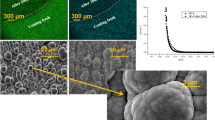Abstract
Alkaline water electrolysis (AWE) is suitable for hydrogen production to develop a fluctuating and uneven-distributed renewable energy-based energy system, because hydrogen is a secondary energy which is suitable to large-scale storage and transportation, and the AWE has a simple configuration using low-cost materials. In this system, the anode typically using Ni and Ni alloys is degraded during the fluctuation of electricity from renewable energy. This degradation is related to the surface hydrous oxide layer which contains Ni(II) and Ni(III). During potential cycling, the hydrous oxide layer grows and increases the electronic resistance due to the redox of Ni(II)/Ni(III) and Ni(III)/Ni(IV). In order to improve the durability and catalytic activity by stabilization of the surface using an electroconductive oxide, a Li x Ni2-x O2/Ni has been developed. The surface oxide was prepared by the oxidation of Ni with a LiOH melt. The Li-doped amount for the surface oxide prepared at 1000 °C was homogeneous with a cubic crystalline structure. On the other hand, the crystalline structure prepared at 800 °C was a mixture of the trigonal and cubic Li-doped NiO phases, which has a high and low Li content, respectively. The oxide layer conductivity increased with the Li-doped amount. The excess Li-doped amount increased not only the conductivity of the oxide layer but also the deactivation of the oxygen evolution reaction (OER) electrocatalytic activity. The durability of the Li x Ni2-x O2/Ni under potential cycling was higher than that of Ni for both the OER activity and redox change of Ni(II)/Ni(III) and Ni(III)/Ni(IV).

Alkaline water electrolysis (AWE) is suitable for hydrogen production to develop a fluctuating and uneven-distributed renewable energy-based energy system, because hydrogen is a secondary energy which is suitable to large-scale storage and transportation, and the AWE has a simple configuration using low-cost materials. In order to improve the durability and catalytic activity by stabilization of the surface using an electroconductive oxide, a Li x Ni2-x O2/Ni has been developed. The oxide layer conductivity increased with the Li-doped amount. The excess Li-doped amount increased not only the conductivity of the oxide layer but also the deactivation of the OER electrocatalytic activity (left). The durability of the Li x Ni2-x O2/Ni under potential cycling was higher than that of Ni for the OER activity (right).













Similar content being viewed by others
References
R.L. Leroy, Industrial water electrolysis: present and future. Int. J. Hydrog. Energy 8(6), 401 (1983)
K. Ota, A. Ishihara, K. Matsuzawa, S. Mitsushima, Hydrogen energy system and environmental impact factor. Electrochemistry 78, 970 (2010)
J. Divisek, H. Schmitz, A bipolar cell for advanced alkaline water electrolysis. Int. J. Hydrog. Energy 7, 703 (1982)
K. Zeng, D. Zhang, Recent progress in alkaline water electrolysis for hydrogen production and applications. Prog. Energy Combust. Sci. 36, 307–326 (2010)
D.E. Hall, Alkaline water electrolysis anode materials. J. Electrochem. Soc. 132, 41 (1985)
P. Rasiyah, A.C.C. Tseung, A mechanistic study of oxygen evolution on Li-doped Co3O4. Electrochem. Soc. 130, 365 (1983)
D. Chanda, J. Hnát, M. Paidar, K. Bouzek, Evolution of physicochemical and electrocatalytic properties of NiCo2O4 (AB2O4) spinel oxide with the effect of Fe substitution at the A site leading to efficient anodic O2 evolution in an alkaline environment. Int. J. Hydrog. Energy 39, 5713 (2014)
M.E.G. Lyons, R.L. Doyle, I. Godwin, M. O’Brien, L. Russell, Hydrous nickel oxide: redox switching and the oxygen evolution reaction in aqueous alkaline solution. J. Electrochem. Soc. 159, H932 (2012)
P.W.T. Lu, S. Srinivasan, EiectrochemicaI-ellipsometric studies of oxide film formed on nickel during oxygen evolution. J. Electrochem. Soc. 125, 1416 (1978)
H. Ichikawa, K. Matsuzawa, Y. Kohno, I. Nagashima, Y. Sunada, Y. Nishiki, A. Manabe, S. Mitsushima, Durability and activity of modified nickel anode for alkaline water electrolysis. ECS Trans. 58(33), 9 (2014)
J. Nadesan, A. Tseung, Oxygen evolution on nickel oxide electrodes. J. Electrochem. Soc. 132, 2957 (1985)
T. Oyama, Y. Iimura, K. Takeuchi, Synthesis of (CrXV1–X)2O3 fine particles by a laser-induced vapor-phase reaction and their crystal structure. J. Mater. Sci. 4, 439 (1999)
W. Shin, N. Murayama, Li-doped nickel oxide as a thermoelectric material. Jpn. J. Appl. Phys. 38, L1336 (1999)
W. Li, J.N. Reimers, J.R. Dahn, Crystal structure of LixNi2−xO2 and a lattice-gas model for the order-disorder transition. Phys. Rev. B 46, 3236 (1992)
W.L. Jang, Y.-M. Lu, W.-S. Hwang, W.-C. Chen, Electrical properties of Li-doped NiO films. J. Eur. Ceram. Soc. 30, 503 (2010)
K.S. Kim, R.E. Davis, Electron spectroscopy of the nickel-oxygen system. J. Elect. Spectros. 1, 254 (1972)
E.L. Ratcliff, J. Meyer, K.X. Steirer, A. Garcia, J.J. Berry, D.S. Ginley, D.C. Olson, A. Kahn, N.R. Armstrong, Evidence for near-surface NiOOH species in solution-processed NiOx selective interlayer materials: impact on energetics and the performance of polymer bulk heterojunction photovoltaics. Chem. Mater. 23, 4988 (2011)
N.S. Mclntyre, T.E. Rummery, M.G. Cook, D. Owen, X-ray photoelectron spectroscopic study of the aqueous oxidation of Monel-400. J. Electrochem. Soc. 123, 1164 (1976)
J. Matienzo, L.I. Yin, S.O. Grim, W.E. Swartz, X-ray photoelectron spectroscopy of nickel compounds. Inorg. Chem. 12, 2764 (1973)
A.F. Carley, S.D. Jackson, J.N. O’Shea, M.W. Roberts, The formation and characterisation of Ni3+ — an X-ray photoelectron spectroscopic investigation of potassium-doped Ni(110)–O. Surf. Sci. 440, L868 (1999)
Acknowledgements
The Institute of Advanced Sciences (IAS) in YNU is supported by the MEXT Program for Promoting the Reform of National Universities. We appreciate all persons involved in this study.
Author information
Authors and Affiliations
Corresponding author
Rights and permissions
About this article
Cite this article
Fujita, S., Nagashima, I., Sunada, Y. et al. Electrocatalytic Activity and Durability of Li x Ni2-x O2/Ni Electrode Prepared by Oxidation with LiOH Melt for Alkaline Water Electrolysis. Electrocatalysis 8, 422–429 (2017). https://doi.org/10.1007/s12678-017-0390-x
Published:
Issue Date:
DOI: https://doi.org/10.1007/s12678-017-0390-x




